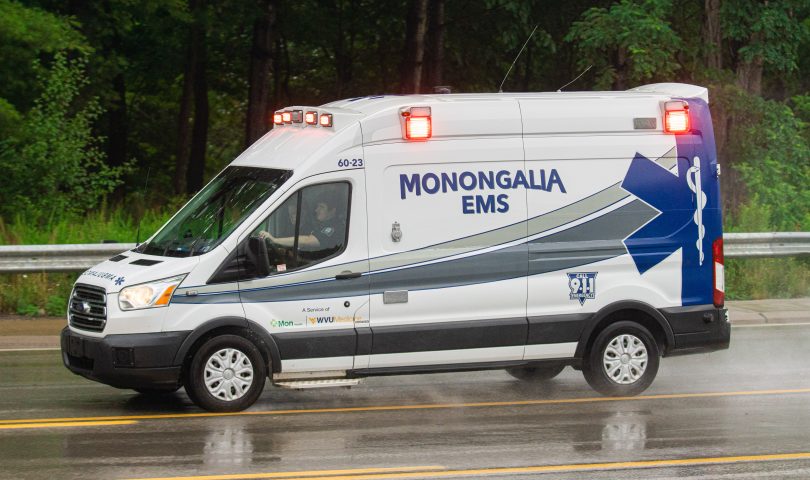Emergency medical services from the comfort of … your couch?
A new state law passed earlier this year will allow EMS personnel to do just that for people with certain medical conditions.
The new “treat-in-place” law will allow some patients to be treated by EMS personnel in the comfort of their own homes instead of being transported to an emergency department — a move Governor Jim Justice said will help alleviate long wait times in emergency departments and keep ambulances from being tied up at the hospital.
“This is a victory for not only the countless lives that will be saved, but the EMS providers they depend on to answer their call,” said Justice, who signed the bill into law on March 9. It officially went into effect May 1.
There are currently only five conditions that can be treated by EMS providers under the new law — diabetes (hypoglycemia), asthma/COPD, seizures, overdoses and cease efforts patients.
“It’s very limited in scope,” said Forest Weyen, Monongalia EMS director. “There’s only a few things that we can do, but we call through our medical command, we provide some onsite treatment for the patient and keep that patient from taking up a very-valuable ED bed and then allowing them to stay at home or wherever they’re at.”
Guidelines for the new law include a protocol checklist for each condition that must be followed to assure the patient doesn’t need to be transported for additional treatment.
For example, when treating a diabetic patient, EMS providers will have to check that glucose levels are stable, heart and respiratory rates are within certain parameters, the patient has access to appropriate medications, a responsible person is able to stay with them, and other various evaluations.
If one thing is outside of the parameters, the patient will be transported to the emergency room.
In recent years, emergency departments have been overwhelmed with patients, often having to divert people to other medical facilities.
“I think the thing that you see in West Virginia and in other places around the nation is emergency departments (ED) are continually full and people use the ED as basically their primary care physician,” Weyen explained.
“Those EDs get clogged because they are required to see the patient and they’re required to do a full assessment and evaluation on them. There are a lot of requirements that they have to deal with.”
By treating patients who need medical care, but not necessarily an emergency room at home, Weyen said it helps make the overall system more available for everyone.
“And we can still take them to the ED and they can always call us back if needed,” he added.
The Department of Health’s Office of Emergency Medical Services Director Joseph Ratliff said Medicaid will also be able to bill for services rendered. “This gives EMS units across the state the added support they need to operate, which will in turn save lives.”
Weyen said the ability to be reimbursed for these services was big for them and definitely a step in the right direction, but he made it clear that all of this only applies to the handful of conditions covered by the law.
“This is a super-small set … there’s like five things,” he said. The thousands of calls they answer for minor injuries and a patient is not transported will still not be billable.
“So back pain is not something that we can get reimbursed for,” he said. “Hypoglycemia? Yes. Back pain? No.”
“But this is a nice small subset. It’s a very clear, concise subset and I think it’s a step in the right direction for health care in West Virginia.”
Treating patients on scene will not really be that much of a stretch from what EMS personnel in Mon County already do.
“There’s a mentality now that we just scoop everybody and run,” Weyen said. “I think the real thing to remember is that the EMS professionals that respond on calls now, we get there, and we assess you, and we begin your treatment, and we do all that stuff on scene anyway.
“We don’t just grab you and run you to the hospital, that was in the ‘50s and ‘60s,” he laughed. “So our folks are used to spending a little more time on scene now. The thing is it’s better for the patients that if they need care, we start that care right away.”
While the treatment will not be a problem, changing staff mentality for what they need to do on scene is part of the learning curve.
Generally, paramedics and EMTs will get some treatments started, then get the patient up and moving to be transported. Now they will have to train their minds for a new treatment option.
Some of the back-side details — like how the billing aspect will work — are still being worked out, but Weyen said he believes the law is really the beginning of getting healthcare to the people of West Virginia, the overall population health and, reducing the overcrowding in emergency departments.
“I think it’s going to be super-beneficial for the community at large and the overall healthcare system at large,” he said. “And when you really start talking about resource allocation and the limited amount of resources we have in West Virginia, that they are being used in the appropriate manner I think is going to be super-helpful.”
TWEET @DominionPostWV




